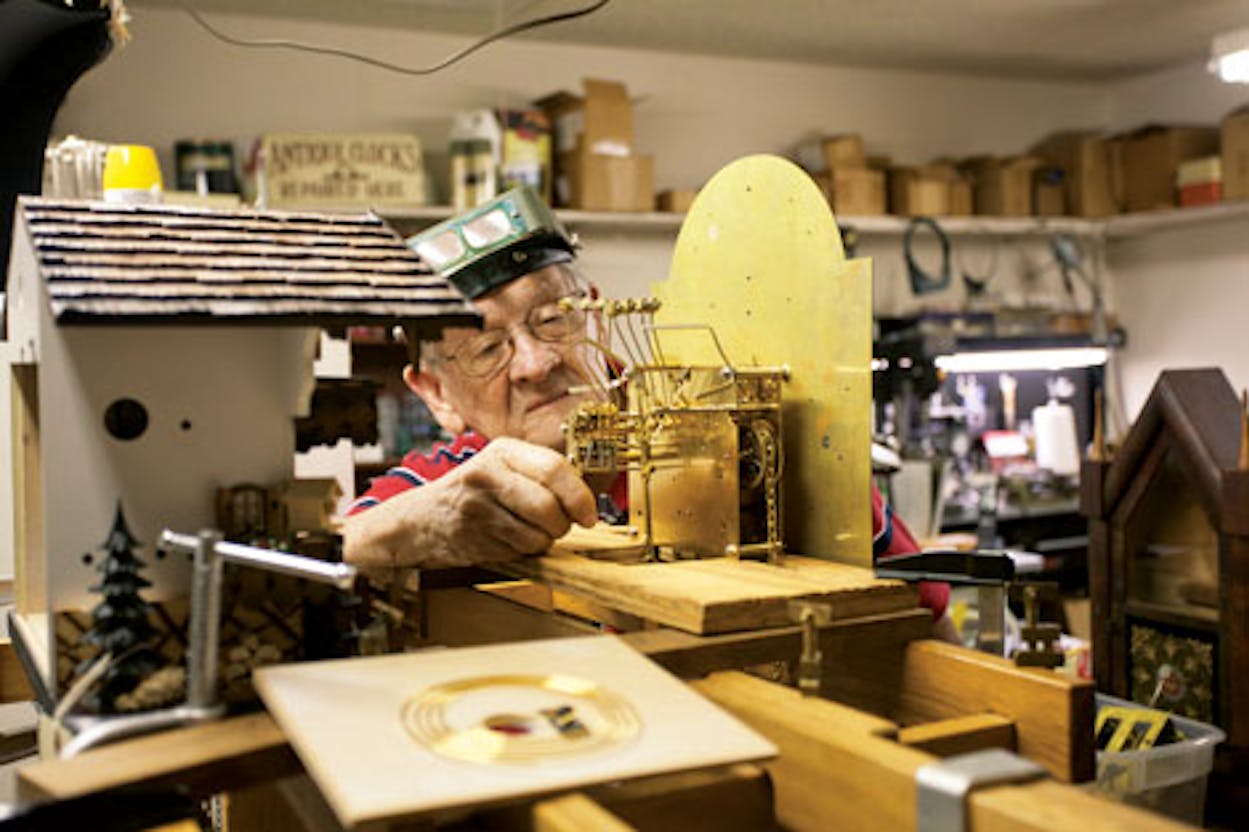Brewer, who moved to Texas from Mississippi after Hurricane Katrina, fixes antique clocks in his Carrollton garage seven days a week. While he has no formal horological training, a 34-year career in rocket science helped him perfect the art of taking things apart.
Tick, tock. Tick and then tock. Most people can’t hear the difference. But fixing clocks for forty years will train your ear.
Whether it’s a grandfather or a cuckoo, they’re all pretty simple. The process of keeping time is analogous to how an automobile works. You’ve got a power source, which is the weight or mainspring, and a transmission, which is the cascade of gears. Then there’s the escapement, a device in the clock that allows power to escape at a given rate—that’s what creates the tick. The escape wheel turns one tooth at a time, rotating a rod known as the verge, which sounds different coming and going because it hits at different angles.
Tick, tock. That’s time going by.
Before I made clocks work, I made sure that rockets did. I started out on fighters and early experimental missiles at North American Aviation. The company, which later became Rockwell International, is now a part of Boeing. When NASA’s moon program began, I moved to the second stage of the Saturn V launch vehicle. We tested early versions of the engines up in the Simi Hills, in Southern California, where they made all those cowboys movies in the forties and fifties. Once the Saturn V program ended, I moved to the shuttle development program.
Sometime before I retired from Rockwell, in 1987, my wife decided to open an antiques business. She bought many clocks for the store, and most of them required fixing. She found a good repairman, but once she paid him, there wasn’t much profit left.
I thought, “Well, crap. She’s never going to make any money.” But what I said was, “I’ll do it for you.”
I now spend my days taking apart clocks that are hundreds of years old. I like making sure they work. I guess that’s not all that different from what I used to do as a quality engineer. Those engines were noisy, complicated rascals.
My work is still complicated, but it sure is more peaceful. I get up at 5 a.m.—without an alarm clock—and I’m out in my shop by 7:30. When I walk in with my cup of coffee and hear them all ticking away, I tell you, it’s like rain on the roof. All the clocks are opened up, and I can see the gears and know what’s happening. I like that I know what’s going on in there.
All my life, I’ve been able to fix things. I started when I was a kid by just repairing things like washers, dryers, and telephones for my mom. It used to be you could go down and buy parts for these things when they were broken. Today it’s not the same. They’re all lights and sensors and plastic molds. If you have a problem and take the darn thing back, they just pull out a new one and tell you to plug that one in.
Not with old clocks, though. There’s no plugging in a new one. I’m working on a clock right now that was made in 1890, a three-weight Vienna regulator with a grande sonnerie strike. I love looking inside it. I see traces from the old craftsmen. Some of the English guys wrote codes inside their timepieces, so they could keep track of their work. I once had a grandfather clock from 1740 that had about a dozen names, dates, and cities written inside, a sort of diary of all the repairs over the years. Sometimes I find less mysterious things inside, from when owners try and do their own fixing: rubber bands, hairpins, safety pins, Scotch tape, nails.
I do a lot of cuckoo clocks. I get them from all over. The other day the UPS guy showed up with two from Mississippi. People just find me. Cuckoo clocks sure are a pain in the neck. But if you’re going to be a clock fixer, you have to know what to do with them. When I open up the back of a thirty-hour or an eight-day cuckoo that was made in, say, the Black Forest of Germany, there are little wires going everywhere, for the animated figures, the waterwheels, the music. I have to take all that out, disconnect everything, see what’s not working, and try to repair the movement and make it keep time. If the cuckoo was made in Russia, the workmanship is always crude. There’s no way to tell whether or not I’ve been successful until I put it all back inside and hope it plays “Edelweiss,” “The Happy Wanderer,” or the theme from Doctor Zhivago. I still don’t know why so many cuckoo clocks play that “Somewhere My Love” waltz.
It takes me two to three hours to fix a clock, unless it’s a cuckoo with woodchoppers and guys climbing ladders. That’s a four-hour job. My wife says I don’t charge enough. I charge folks what I think is fair. Like with the grande sonnerie, I charged $150 to get it telling time again. Other places would have charged $350. I’m not trying to get rich. I’ve got little old ladies bringing me clocks that have been in their family for generations. They live on fixed incomes. I try to make it easy on people if I can. But house calls are always an additional $100.
I’d like to find a way to slow time down. Or speed it up. But otherwise I don’t worry too much about its passage. Of course, I’d like to stick around for a while longer, but I’m not afraid of time moving on. The second hand has to stop one day.







